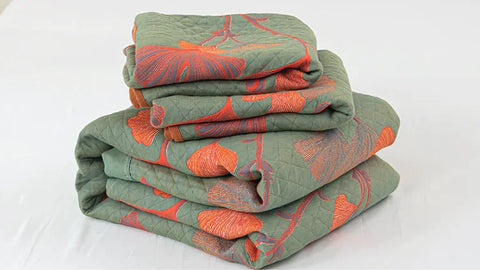Bed sheets accumulate dust mites, sweat, skin debris and other dirt over time, affecting our health and sleep. When faced with washing bed sheets, many people will choose to use a washing machine, which saves both time and effort. But if the method is not correct, it will shorten the service life of the sheets or even damage them.This article will show you how to use a washing machine to clean your sheets or if you have any other questions about your sheets you can always contact us.

Preparing Your Sheets for the Wash
Before tossing your bed sheets into the washing machine, taking a few preparatory steps is essential to ensure a thorough and effective cleaning process.
Check the Care Label
The care label on your bed sheets provides valuable information on how to properly launder them. It specifies the recommended water temperature, whether the sheets can be bleached, and if there are any special instructions for drying. Wash sheets according to the guidelines provided on the care label to maintain their quality and longevity.
Sorting Sheets by Color and Fabric Type
Separating your bed sheets by color and fabric type is crucial to prevent color bleeding and damage during the wash cycle. Wash sheets of similar colors together to avoid any potential color transfer. Additionally, different fabric types may require specific washing conditions, so sorting them accordingly ensures that each set receives the appropriate care.
Checking for Stains and Pre-treating Them
Inspecting your bed sheets for stains before laundering is vital in ensuring that they come out of the wash looking fresh and clean. Various methods for pre-treating and removing stains from bed sheets are recommended, including dish soap, hydrogen peroxide, pre-wash stain remover, white vinegar, and water mixture. Pre-treating stains before washing is vital to effectively remove dirt and other particles, prevent fading, and maintain the fabric's appearance.
By taking these preparatory steps before starting the washing process, you can ensure that your bed sheets receive optimal care during laundering.
Selecting the Right Detergent
When washing bed sheets, selecting the right detergent is crucial for maintaining their quality and cleanliness. Different types of detergents are available, each catering to specific fabric types and cleaning needs.
Types of Detergents for Bed Sheets
- Tide-Free and Gentle Liquid Laundry Detergent: This detergent is suitable for delicate fabrics and is an ideal choice for different types of bed sheets. Its gentle formula ensures that the fabric remains soft while effectively removing dirt and odors.
- Tide Original Powder Laundry Detergent: If your bedding is made of cotton or linen, this detergent is a great option. It is designed to remove tough stains and leaves the fabric feeling soft and smelling fresh after each wash.
- Silk or satin-friendly detergents: For delicate fabrics such as silk and satin sheets, using a specialized detergent designed specifically for these materials is essential. These detergents are formulated to clean gently without causing damage or discoloration to the fabric.
Considering the material of your bed sheets will help determine which type of detergent is best suited for them. Using a detergent that aligns with the fabric's needs ensures that it receives proper care during the washing process.

How Much Detergent to Use
The amount of detergent needed depends on factors such as water hardness, load size, and soil level. Generally, use approximately 1-2 ounces of liquid detergent or 2-4 tablespoons of powdered detergent per regular load. However, it's important to refer to the manufacturer's instructions on the product packaging for precise measurements based on your specific washing machine and water conditions.
By selecting a suitable detergent tailored to your bed sheets' fabric type and following recommended usage guidelines, you can effectively clean your sheets while preserving their quality.
In the next section, we will explore the best mode of washing sheets in a washing machine, covering essential considerations such as temperature settings and spin speed.
What is the Best Mode of Washing Sheets?
Regarding washing sheets, several factors need to be considered to determine the most suitable washing mode. These factors include the material of the bed sheet, the choice of detergent, and the temperature at which to wash the sheets.
Determining the Material of a Bed Sheet
Different fabrics require different care during laundering. For instance, cotton quilt are best washed at a lower temperature to protect longevity. It is suggested to wash them in warm water and tumble dry on low to extend the life of bedding. On the other hand, delicate fabrics such as silk or satin sheets may require a more gentle washing cycle with cooler temperatures to prevent damage.
Choosing the Right Detergent
Selecting an appropriate detergent tailored to the fabric type is essential for maintaining the quality of bed sheets. For instance, using Tide Free and Gentle Liquid Laundry Detergent for delicate fabrics ensures they remain soft while effectively removing dirt and odors. Each detergent caters to specific fabric types and cleaning needs, contributing to preserving the fabric's integrity.
Knowing the Temperature at Which to Wash Your Sheets
Washing temperature can seriously affect the integrity of your bed linen fabric. When washing sheets, it is important to consider both hot and cold water temperatures. Hot water is effective at killing germs and bacteria, making it ideal for heavily soiled items and removing allergens. However, hot water can cause shrinkage, and discoloration, and may damage certain fabrics such as silk or satin. On the other hand, cool water is gentle on fabrics and maintains their vibrancy, especially for brightly colored bedding.
The temperature at which you wash varies for different materials. For tough fabrics such as cotton and synthetics, using warm water (about 90-110°F) provides an effective balance between cleaning power and fabric care. This temperature range effectively removes dirt and stains while minimizing the risk of fabric damage.
Delicate fabrics such as silk require lower water temperatures (approximately 80°F) to prevent damage and maintain their luxurious feel. Lower water temperatures ensure gentle cleaning of these fabrics without compromising their quality. Therefore, be sure to check the wash label on your sheets for specific washing instructions regarding temperature recommendations.
Choosing the Spin Speed Of the Washing Machine
The spin speed setting on a washing machine plays a significant role in the cleanliness and care of bed sheets. It determines how much water is extracted from the fabric during the wash cycle, affecting the drying time and overall fabric integrity.
Scientific Research Findings:
- Exposure to high heat degrades textiles over time.
- Hot water most effectively kills germs and bacteria.
When washing bed sheets, it is advisable to select a moderate spin speed to prevent excessive wrinkling and potential damage to the fabric. High spin speeds can cause wear and tear on the fibers, leading to premature deterioration of the sheets. Conversely, a low spin speed may leave excess moisture in the fabric, prolonging drying time and potentially causing musty odors.
To maintain the quality and longevity of bed sheets, opt for a medium spin speed setting on your washing machine.
This ensures effective water extraction without subjecting the fabric to unnecessary strain. Additionally, consider removing the sheets promptly after the wash cycle ends to minimize wrinkles and facilitate quicker drying.
By choosing an appropriate spin speed, individuals can preserve their bed sheets' condition while promoting efficient laundering practices.
Drying and Storing Your Sheets
Choosing the proper drying method and following best practices are also necessary when drying sheets. In another interview, Mary Gagliardi emphasizes that different fabrics have different temperature needs. One of the most effective ways to dry sheets is to use a clothesline outdoors. The ultraviolet rays of the sun are a natural disinfectant that helps eliminate bacteria and odors, as well as providing a fresh scent.
However, it's important to avoid prolonged exposure to direct sunlight as it can cause fading over time. Alternatively, an indoor drying rack or clothesline is suitable for preserving the color of fabrics while protecting them from damage that may be caused by excessive sunlight.
Another way to dry your sheets is to tumble dry them, and when doing so, it's important to avoid over-drying. Overheating can cause the fabric to shrink and fray, compromising the overall integrity of the sheets. To avoid this, remove your sheets from the dryer while they are still slightly damp and air dry, or hang them on a flat surface.
Folding and Storing Sheets for Freshness
After washing and drying your sheets, proper folding and storage techniques should not be overlooked. To maintain the freshness of your sheets, fold them neatly as soon as they are completely dry. This helps prevent sheets from wrinkling and ensures they stay flat the next time you use them. When storing folded sheets, consider placing a packet of lavender or other aromatic plants in a linen cabinet or drawer to give your sheets a pleasant scent.

Conclusion
Properly preparing sheets for laundering by checking care labels, sorting by color and fabric type, and pre-treating stains can be further enhanced by choosing the right detergent for the fabric type and using the right amount of detergent. By incorporating these practices into your daily laundry routine, individuals can enjoy clean, fresh-smelling sheets that help create a comfortable and healthy sleeping environment.
If you are in need of new sheets, feel free to browse our one-stop home furnishing online store.
Related read:

